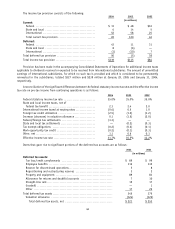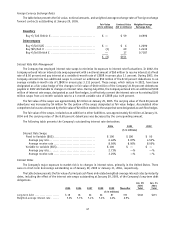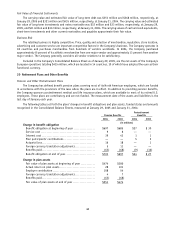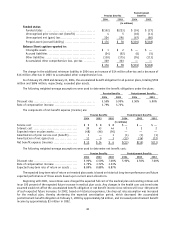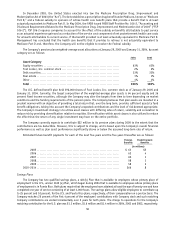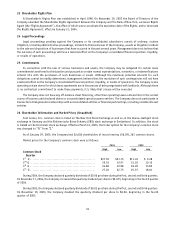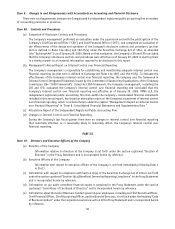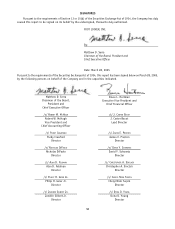Foot Locker 2004 Annual Report Download - page 66
Download and view the complete annual report
Please find page 66 of the 2004 Foot Locker annual report below. You can navigate through the pages in the report by either clicking on the pages listed below, or by using the keyword search tool below to find specific information within the annual report.
In December 2003, the United States enacted into law the Medicare Prescription Drug, Improvement and
Modernization Act of 2003 (the “Act”). The Act establishes a prescription drug benefit under Medicare, known as “Medicare
Part D,” and a Federal subsidy to sponsors of retiree health care benefit plans that provide a benefit that is at least
actuarially equivalent to Medicare Part D. In May 2004, the FASB issued FASB Staff Position No. 106-2, “Accounting and
Disclosure Requirements Related to the Medicare Prescription Drug, Improvement and Modernization Act of 2003” (“FSP
106-2”). FSP 106-2 requires companies to account for the effect of the subsidy on benefits attributable to past service
as an actuarial experience gain and as a reduction of the service cost component of net postretirement health care costs
for amounts attributable to current service, if the benefit provided is at least actuarially equivalent to Medicare Part D.
Management has concluded that the health care benefits that it provides to retirees is not actuarially equivalent to
Medicare Part D and, therefore, the Company will not be eligible to receive the Federal subsidy.
The Company’s pension plan weighted-average asset allocations at January 29, 2005 and January 31, 2004, by asset
category are as follows:
2004 2003
Asset Category
Equity securities ................................................................ 63% 63%
Foot Locker, Inc. common stock ................................................. 2% 2%
Debt securities................................................................... 33% 33%
Real estate ...................................................................... 1% 1%
Other ............................................................................ 1% 1%
Total ............................................................................ 100% 100%
The U.S. defined benefit plan held 396,000 shares of Foot Locker, Inc. common stock as of January 29, 2005 and
January 31, 2004. Currently, the target composition of the weighted-average plan assets is 64 percent equity and 36
percent fixed income securities, although the Company may alter the targets from time to time depending on market
conditions and the funding requirements of the pension plans. The Company believes that plan assets are invested in a
prudent manner with an objective of providing a total return that, over the long term, provides sufficient assets to fund
benefit obligations, taking into account the Company’s expected contributions and the level of risk deemed appropriate.
The Company’s investment strategy is to utilize asset classes with differing rates of return, volatility and correlation to
reduce risk by providing diversification relative to equities. Diversification within asset classes is also utilized to reduce
the effect that the return of any single investment may have on the entire portfolio.
The Company currently expects to contribute $22 million to its pension plans during 2005 to the extent that the
contributions are tax deductible. However, this is subject to change, and is based upon the Company’s overall financial
performance as well as plan asset performance significantly above or below the assumed long-term rate of return.
Estimated future benefit payments for each of the next five years and the five years thereafter are as follows:
Pension
Benefits
Postretirement
Benefits
(in millions)
2005 ...................................................................... $ 63 $5
2006 ...................................................................... 62 4
2007 ...................................................................... 60 3
2008....................................................................... 58 3
2009 ...................................................................... 58 2
2010–2014 ...................................................................... 266 8
Savings Plans
The Company has two qualified savings plans, a 401(k) Plan that is available to employees whose primary place of
employment is the U.S., and an 1165 (e) Plan, which began during 2004 that is available to employees whose primary place
of employment is in Puerto Rico. Both plans require that the employees have attained at least the age of twenty-one and have
completed one year of service consisting of at least 1,000 hours. The savings plans allow eligible employees to contribute up
to 25 percent and 10 percent, for the U.S. and Puerto Rico plans, respectively, of their compensation on a pre-tax basis. The
Company matches 25 percent of the first 4 percent of the employees’ contributions with Company stock and such matching
Company contributions are vested incrementally over 5 years for both plans. The charge to operations for the Company’s
matching contribution for the U.S. plan was $1.3 million, $1.6 million and $1.4 million in 2004, 2003 and 2002, respectively.
50






